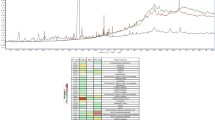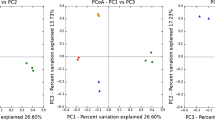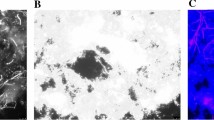Abstract
Hydrogen sulfide (H2S) is one of the major tannery wastewater pollutants. Up today, chemical scrubbing is the most established technology for H2S removal in wastewater treatment plants. However, this procedure increases both the operating costs and the carbon footprint of the treatment. On the other hand, biological treatment is an emerging and sustainable technology for air pollution control. Our study focuses on the biological sulfur-oxidizing potential of autochthonous sludge of a plant treating tannery wastewater, located in Santa Croce (Tuscany, Italy). We propose a multidisciplinary approach to investigate two aspects: first, the composition of the microbial community both in the biological sludge and in the primary sludge and second, the sulfur-oxidizing potential of these native matrices. In order to do that, biological and primary sludge were used as inoculum in a reactor fed with sulfides. Then, traditional cultivation techniques were combined with several molecular approaches for analyzing the microbial community structure with a special focus on sulfur-oxidizing bacteria (SOB). Our study demonstrated that the use of different techniques was fundamental in order to detect the largest number of sulfur-oxidizing bacterial components; in particular, the detection of less represented components was guaranteed only by the performed multidisciplinary approach. Our study demonstrated the optimal performances of the reactor in selecting a sulfur-oxidizing biomass from autochthonous matrices. In addition, the importance of the primary sludge as inoculum for sulfur-oxidizing reactors was proved.




Similar content being viewed by others
References
Aguilar, J. R. P., Cabriales, J. J. P., & Vega, M. M. (2008). Identification and characterization of sulfur-oxidizing bacteria in an artificial wetland that treats wastewater from a tannery. International Journal of Phytoremediation, 10(5), 359–370.
Altschul, S. F., Madden, T. L., Schäffer, A. A., Zhang, J., Zhang, Z., Miller, W., & Lipman, D. J. (1997). Gapped BLAST and PSI-BLAST: a new generation of protein database search programs. Nucleic Acids Research, 25(17), 3389–3402.
Amann, R. I., Krumhol, Z. L., & Stahl, D. A. (1990). Fluorescent-oligonucleotide probing of whole cells for determinative, phylogenetic, and environmental studies in microbiology. Journal of Bacteriology, 172, 762–770.
Buzas, M. A., & Gibson, T. G. (1969). Species diversity: benthonic foraminifera in western North Atlantic. Science, 163(3862), 72–75.
Celis-Garcia, L. B., Gonzalez-Blanco, G., & Meraz, M. (2008). Removal of sulfur inorganic compounds by a bio film of sulfate reducing and sulfide oxidizing bacteria in a down-flow fluidized bed reactor. Journal of Chemical Technology and Biotechnology, 83, 260–268.
Cha, J. M., Cha, W. S., & Lee, J. H. (1999). Removal of organo-sulphur odour compounds by Thiobacillus novellas SRM, sulphur-oxidizing microorganisms. Process Biochemistry, 34(6–7), 659–665.
Chen, J., Tang, Y. Q., & Wu, X. L. (2012). Bacterial community shift in two sectors of a tannery plant and its Cr (VI) removing potential. Geomicrobiology Journal, 29(3), 226–235.
Chung, Y. C., Ho, K. L., & Tseng, C. P. (2003). Hydrogen sulfide gas treatment by a chemical-biological process: chemical absorption and biological oxidation steps. Journal of Environmental Science Health, 38(5), 663–679.
Demaneche, S., Sanguin, H., Pote, J., Navarro, E., Bernillon, D., Mavingui, P., Wildi, W., Vogel, T. M., & Simonet, P. (2008). Antibiotic-resistant soil bacteria in transgenic plant fields. PNAS, 105, 3957–3962.
Deshusses, M. A., & Cox, H. H. J. (1998). Biological waste and air treatment in biotrickling filters. Current Opinion in Biotechnology, 9, 256–262.
Desta, A. F., Assefa, F., Leta, S., Stomeo, F., Wamalwa, M., Njahira, M., & Appolinaire, D. (2014). Microbial community structure and diversity in an integrated system of anaerobic-aerobic reactors and a constructed wetland for the treatment of tannery wastewater in Modjo, Ethiopia. Plos One, 10(5), e0128053.
Duan, H., Koe, L. C., & Yan, R. (2005). Treatment of H2S using a horizontal biotrickling filter based on biological activated carbon: reactor setup and performance evaluation. Applied Microbiology and Biotechnology, 67, 143–149.
Durai, G., & Rajasimman, M. (2014). Biological treatment of tannery wastewater: a review. Journal of Environmental Science and Technology, 4, 1–17.
Gabriel, D., Cox, H. J., & Deshusses, M. A. (2004). Conversion of full-scale wet scrubbers to biotrickling filters for H2S control at publicly owned treatment works. Journal of Environmental Engineering, 130, 1110–1117.
Gianico, A., Braguglia, C. M., Mascolo, G., & Mininni, G. (2013). Partitioning of nutrients and micropollutants along the sludge treatment line: a case study. Environmetal Science and Pollution Research, 20, 6256–6265.
Gram, H.C., (1884). Fortschritte Medizin, 2, 185–89
Huber, T., Faulkner, G., & Hugenholtz, P. (2004). Bellerophon: a program to detect chimeric sequences in multiple sequence alignments. Bioinformatics, 20(14), 2317–2319.
Jin, Y., Veiga, M. C., & Kennes, C. (2005). Autotrophic deodorization of hydrogen sulfide in a biotrickling filter. Journal of Chemical Technology and Biotechnology, 80(9), 967–1087.
Kantachote, D.; Charernjiratrakul, W.; Noparatnaraporn, N. & Oda, K. (2008). Selection of sulfur oxidizing bacterium for sulfide removal in sulfate rich wastewater to enhance biogas production. Electronic Journal of Biotechnology, 11(2).
Kelly, D. P., & Harrison, A. P. (1989). The genus Thiobacillus. In J. Staley (Ed.), Bergey’s manual of systematic bacteriology (Vol. 3, pp. 1842–1858). Baltimore: Williams and Wilkins.
Kleerebezem, R., & Mendez, R. (2002). Autotrophic denitrification for combined hydrogen sulfide removal from biogas and post-denitrification. Water Science and Technology, 45(10), 349–356.
Kletzin, A., Dahl, C., & Friedrich, C.G. (2008). Oxidation of sulfur and inorganic sulfur compounds in Acidianus ambivalens. Microbial Sulfur Metabolism, 184e201.
Korajkic, A., Parfrey, L. V., McMinn, B. R., Baeza, Y. V., VanTeuren, W., Knight, R., & Shanks, O. C. (2015). Changes in bacterial and eukaryotic communities during sewage decomposition in Mississippi River water. Water Wesearch, 69, 30–39.
Lane, D. J., Harrison, A. P., Stahl, D. A., Pace, B., Giovannoni, S. J., Olsen, G. J., et al. (1991). Evolutionary relationship among sulfur and iron oxidizing eubacteria. Journal of Bacteriology, 174, 269–278.
Lee, E. Y., Lee, N. I., Chob, K. S., & Ryu, H. W. (2006). Removal of hydrogen sulfide by sulfate-resistant Acidithiobacillus thiooxidans AZ11. Journal of Bioscience and Bioengineering, 101(4), 309–314.
Lefebvre, O., Vasudevan, N., Thanasekaran, K., Moletta, R., & Godon, J. J. (2006). Microbial diversity in hypersaline wastewater: the example of tanneries. Extremophiles, 10, 505–513. Springer-Verlag.
Lofrano, G., Meriç, S., Zengin, G. E., & Orhon, D. (2013). Chemical and biological treatment technologies for leather tannery chemicals and wastewaters: a review. Science of the Total Environment, 461–462, 265–281.
Ludwig, W., Strunk, O., Westram, R., Richter, L., Meier, H., Yadhukumar, Buchner, A., Lai, T., Steppi, S., Jobb, G., Förster, W., Brettske, I., Gerber, S., Ginhart, A. W., Gross, O., Grumann, S., Hermann, S., Jost, R., König, A., Liss, T., Lüssmann, R., May, M., Nonhoff, B., Reichel, B., Strehlow, R., Stamatakis, A., Stuckmann, N., Vilbig, A., Lenke, M., Ludwig, T., Bode, A., & Schleifer, K. H. (2004). ARB: a software environment for sequence data. Nucleic Acids Research, 32(4), 1363–1371.
Luo, J., Tian, G., & Lin, W. (2013). Enrichment, isolation and identification of sulfur-oxidizing bacteria from sulfide-removing bioreactor. Journal of Environmental Science, 25(7), 1393–1399.
Mahmood, Q., Hu, B. L., Cai, J., Zheng, P., Azim, M. R., Jilani, G., & Islam, E. (2009). Isolation of Ochrobactrum sp. QZ2 from sulfide and nitrite treatment system. Journal of Hazardous Materials, 165(1–3), 558–565.
Mannucci, A., Munz, G., Mori, G., & Lubello, C. (2014). Factors affecting biological sulphate reduction in tannery wastewater treatment. Environmental Engineering Management Journal, 4(13), 1005–1012.
Meyer, B., Imhoff, J. F., & Kuever, J. (2007). Molecular analysis of the distribution and phylogeny of the soxB gene among sulphur-oxidizing bacteria—evolution of the Sox sulphur oxidation enzyme system. Environmental Microbiology, 9, 2957–2977.
Móra, R. R., & Amann, R. (2015). Past and future species definitions for Bacteria and Archaea. Systematic and Applied Microbiology, 38, 209–216.
Moter, A., & Gobel, U. B. (2000). Fluorescence in situ hybridization (FISH) for direct visualization of microorganisms. Journal of Microbiological Methods, 41, 85–112.
Moussavi, G., Naddafi, K., & Mesdaghinia, A. (2007). Developing a biofilm of sulfur oxidizing bacteria, starting-up and operating a bioscrubber treating H2S. Pakistan Journal of Biological Sciences, 10(5), 701–709.
Oh, M. H., Lee, S. M., Hong, S. H., Choi, H. N., Kim, I. S., & Lee, E. Y. (2014). Solubilization of primary sewage sludge by freeze-dried Lactobacillus brevis. International Biodeterioration & Biodegradation, 95(A), 195–199.
Okabe, S., Odagiri, M., Ito, T., & Satoh, H. (2007). Succession of sulfur-oxidizing bacteria in the microbial community on corroding concrete in sewer systems. Applied and Environmental Microbiology, 73(3), 971–980.
Pervin, H. M., Batstone, D. J., & Bond, P. L. (2013). Previously unclassified bacteria dominate during thermophilic and mesophilic anaerobic pre-treatment of primary sludge. Systematic and Applied Microbiology, 36(4), 281–290.
Quast, C., Pruesse, E., Yilmaz, P., Gerken, J., Schweer, T., Yarza, P., Peplies, J., & Glöckner, F. O. (2013). The SILVA ribosomal RNA gene database project: improved data processing and web-based tools. Nucleic Acids Research, 41, D590–D596.
Ravichandra, P., Ramakrishna, M. A., Gangagni, R., & Annapurna, J. (2006). Sulfide oxidation in a batch fluidized bed bioreactor using immobilized cells of isolated Thiobacillus sp. (Iict-Sob-Dairy-201) as biocatalyst. Journal of Engineering Science and Technology, 1(1), 21–30.
Sahinkaya, E., Hasar, H., Kaksonen, A. H., & Rittmann, B. E. (2011). Performance of a sulfide-oxidizing, sulfur-producing membrane biofilm reactor treating sulfide-containing bioreactor effluent. Environmental Science & Technology, 45(9), 4080–4087.
Shao, M. F., Zhang, T., & Fang, H. H. P. (2010). Sulfur-driven autotrophic denitrification: diversity, biochemistry, and engineering applications. Applied Microbiology and Biotechnology, 88, 1027e1042.
Shareefdeen, Z. & Singh, A. (2005). Biotechnology for odor and air pollution control. Springer.
Sharma, S., & Adholeya, A. (2011). Detoxification and accumulation of chromium from tannery effluent and spent chrome effluent by Paecilomyces lilacinus fungi. International Biodeterioration & Biodegradation, 65, 309–317.
Snaidr, J., Amann, R., Huber, I., Ludwig, W., & Schleifer, K. H. (1997). Phylogenetic analysis and in situ identification of bacteria in activated sludge. Applied and Environmental Microbiology, 63, 2884–2896.
Sorokin, D. Y., Tourova, T. P., Spiridonova, E. M., Rainey, F. A., & Muyzer, G. (2005). Thioclava pacifica gen. nov., sp. nov., a novel facultatively autotrophic, marine, sulfur-oxidizing bacterium from a near-shore sulfidic hydrothermal area. International Journal of Systematic and Evolutionary Microbiology, 55(3), 1069–1075.
Stackebrandt, E., & Ebers, J. (2006). Taxonomic parameters revisited: tarnished gold standards. Microbiology Today, 33, 152–155.
Sublette, K. L., Kolhatkar, R., & Raterman, K. (1998). Technological aspects of the microbial treatment of sulfide-rich wastewaters: a case study. Biodegradation, 9(3–4), 259–271.
Tchobanoglous, G., Burton, F., & Stensel, H. (2003). Waste-water engineering treatment and reuse. New York: McGraw-Hill Metcalf and Eddy Inc.
Vannini, C., Rosati, G., Verni, F., & Petroni, G. (2004). Identification of the bacterial endosymbionts of the marine ciliate Euplotes magnicirratus (Ciliophora, Hypotrichia) and proposal of ‘Candidatus Devosia euplotis’. International Journal of Systematic and Evolutionary Microbiology, 54(Pt 4), 1151–1156.
Vannini, C., Munz, G., Mori, G., Lubello, C., Verni, F., & Petroni, G. (2008). Sulphide oxidation to elemental sulphur in a membrane bioreactor: performance and characterization of the selected microbial sulphur-oxidizing community. Systematic and Applied Microbiology, 31, 461–473.
Vidyalakshmi, R., & Sridar, R. (2006). Isolation and characterization of sulphur oxidizing bacteria. Journal of Culture Collections, 5, 73–77.
Vishniac, W., & Santer, M. (1957). The Thiobacilli. Bacteriological Reviews, 21(3), 195–213.
Waksman, S. A. (1922). Microorganisms concerned in the oxidation of sulfur in the soil. Journal of Bacteriology, 7(6), 605–608.
Zuber, L., Dunn, L., & Deshusses, M. A. (1997). Comparative scale up and biotrickling filter and three-phase air lift bioreactor for the removal of methylene chloride from polluted air. Journal of the Air and Waste Management Association, 47, 969–975.
Zupancic, G. D., & Jemec, A. (2010). Anaerobic digestion of tannery waste: semi-continuous and anaerobic sequencing batch reactor processes. Bioresource Technology, 101, 26–33.
Acknowledgments
The authors wish to thank S. Gabrielli for his help with graphic artwork. The authors acknowledge the European Union for supporting this work in the frame of the LIFE+ program (BIOSUR project, LIFE11 ENV/IT/075) and through the Marie Curie IRSES program (Carbala project 295176).
Author information
Authors and Affiliations
Corresponding author
Rights and permissions
About this article
Cite this article
Giordano, C., Spennati, F., Melone, A. et al. Biological Sulfur-Oxidizing Potential of Primary and Biological Sludge in a Tannery Wastewater Treatment Plant. Water Air Soil Pollut 226, 391 (2015). https://doi.org/10.1007/s11270-015-2656-3
Received:
Accepted:
Published:
DOI: https://doi.org/10.1007/s11270-015-2656-3




